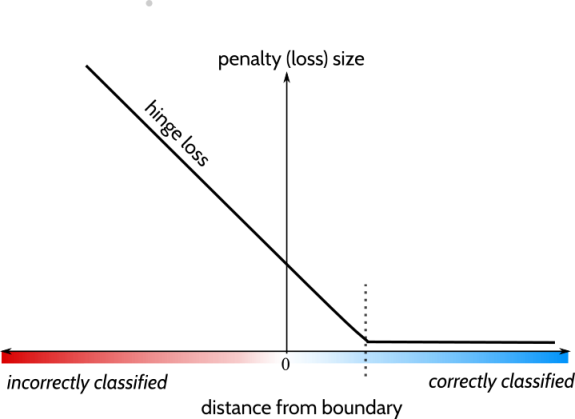caffe 源码学习笔记(8) loss function
背景
虽然不太care 训练的过程,但是由于容易看懂的layer都看得差不多了 所以打算看一下这些loss function.
Euclidean Loss (L2 loss)

一般用于“real-valued regression tasks” 。 比如之前的项目上用的人脸年龄模型,就是用了这个Loss
这个loss没什么额外的参数,实现也很简单。
1
2template <typename Dtype>
3void EuclideanLossLayer<Dtype>::Reshape(
4 const vector<Blob<Dtype>*>& bottom, const vector<Blob<Dtype>*>& top) {
5 LossLayer<Dtype>::Reshape(bottom, top);
6 CHECK_EQ(bottom[0]->count(1), bottom[1]->count(1))
7 << "Inputs must have the same dimension.";
8 diff_.ReshapeLike(*bottom[0]);
9}
10
11template <typename Dtype>
12void EuclideanLossLayer<Dtype>::Forward_cpu(const vector<Blob<Dtype>*>& bottom,
13 const vector<Blob<Dtype>*>& top) {
14 int count = bottom[0]->count();
15 caffe_sub(
16 count,
17 bottom[0]->cpu_data(),
18 bottom[1]->cpu_data(),
19 diff_.mutable_cpu_data());
20 Dtype dot = caffe_cpu_dot(count, diff_.cpu_data(), diff_.cpu_data());
21 Dtype loss = dot / bottom[0]->num() / Dtype(2);
22 top[0]->mutable_cpu_data()[0] = loss;
23}
注意要Reshape中,要求两个bottom blob(第一个为预测结果,第二个为gt)的batch维度可以不同,计算时按照预测结果的个数为准。
以及,Mean Square Error(MSE) 和L2 loss的差别只是一个系数1/2,可以放在一起说明。

MultinomialLogisticLoss

用于单标签多分类任务。 输入的预测blob是一个(通常是经过softmax后)得到的概率分布。
注意 " The SoftmaxWithLossLayer should be preferred over separate SoftmaxLayer + MultinomialLogisticLossLayer as its gradient computation is more numerically stable."
这个后面会提到。
同样,这个loss也没什么额外参数, forward也很简单
1
2template <typename Dtype>
3void MultinomialLogisticLossLayer<Dtype>::Forward_cpu(
4 const vector<Blob<Dtype>*>& bottom, const vector<Blob<Dtype>*>& top) {
5 const Dtype* bottom_data = bottom[0]->cpu_data();
6 // predictions,NxCxHxW
7 const Dtype* bottom_label = bottom[1]->cpu_data();
8 // labels, Nx1x1x1
9 int num = bottom[0]->num();
10 int dim = bottom[0]->count() / bottom[0]->num();
11 // dim 表示类别总数
12 Dtype loss = 0;
13 // bottom_data[i * dim + label]表示的是第i张图的gt对应的位置的预测分数
14 for (int i = 0; i < num; ++i) {
15 int label = static_cast<int>(bottom_label[i]);
16 Dtype prob = std::max(
17 bottom_data[i * dim + label], Dtype(kLOG_THRESHOLD));
18 loss -= log(prob);
19 }
20 top[0]->mutable_cpu_data()[0] = loss / num;
21}
需要注意的已经写在注释中了。 kLOG_THRESHOLD是一个很小的值,1E-20,防止log0炸掉
hinge-loss
中文似乎叫"合页损失函数",因为很像一本书打开的样子(?

主要用在svm中。。。所以其实没在工作中实际接触过这个。
这个loss的特点是更加严格。。严格的意思是说,分类的结果不仅需要正确,而且需要置信度足够高,损失才会是0.

forward代码稍微不是那么直接
1
2 const Dtype* bottom_data = bottom[0]->cpu_data();
3 Dtype* bottom_diff = bottom[0]->mutable_cpu_diff();
4 const Dtype* label = bottom[1]->cpu_data();
5 int num = bottom[0]->num();
6 int count = bottom[0]->count();
7 int dim = count / num;
8 // dim是类别数
9
10 caffe_copy(count, bottom_data, bottom_diff);
11 // 把预测值bottom_data拷贝到bottom_diff
12 for (int i = 0; i < num; ++i) {
13 bottom_diff[i * dim + static_cast<int>(label[i])] *= -1;
14 }
15 // 把gt的那一类的预测分数取了相反数(这里相当于算了condition函数,只不过差个负号)
16
17 for (int i = 0; i < num; ++i) {
18 for (int j = 0; j < dim; ++j) {
19 bottom_diff[i * dim + j] = std::max(
20 Dtype(0), 1 + bottom_diff[i * dim + j]);
21 }
先算了一个bottom_diff。 这里其实是相当于算了condition function的结果,只不过差了一个负号。 后面我们也可以看到
1
2bottom_diff[i * dim + j] = std::max(
3 Dtype(0), 1 + bottom_diff[i * dim + j]);
中是计算了bottom_diff[i * dim + j] = std::max( Dtype(0), 1 + bottom_diff[i * dim + j]);
还值得一提的是,caffe的hinge loss 同时支持L1 norm和L2 norm(在L2-SVM中使用)
1
2message HingeLossParameter {
3 enum Norm {
4 L1 = 1;
5 L2 = 2;
6 }
7 // Specify the Norm to use L1 or L2
8 optional Norm norm = 1 [default = L1];
9}
1
2 Dtype* loss = top[0]->mutable_cpu_data();
3 switch (this->layer_param_.hinge_loss_param().norm()) {
4 case HingeLossParameter_Norm_L1:
5 loss[0] = caffe_cpu_asum(count, bottom_diff) / num;
6 break;
7 case HingeLossParameter_Norm_L2:
8 loss[0] = caffe_cpu_dot(count, bottom_diff, bottom_diff) / num;
9 break;
10 default:
11 LOG(FATAL) << "Unknown Norm";
12 }
13}
参考资料
Posts in this Series
- caffe 源码阅读笔记
- [施工中]caffe 源码学习笔记(11) softmax
- caffe 源码学习笔记(11) argmax layer
- caffe 源码学习笔记(10) eltwise layer
- caffe 源码学习笔记(9) reduce layer
- caffe 源码学习笔记(8) loss function
- caffe 源码学习笔记(7) slice layer
- caffe 源码学习笔记(6) reshape layer
- caffe 源码学习笔记(5) 卷积
- caffe 源码学习笔记(4) 激活函数
- caffe 源码学习笔记(3) Net
- caffe 源码学习笔记(2) Layer
- caffe 源码学习笔记(1) Blob
